MUSC3336: The Technological Development of Music in Media
VerifiedAdded on 2022/10/31
|10
|2480
|394
Essay
AI Summary
This essay examines the technological development of music and sound recording across various eras, from the acoustic era's mechanical devices to the digital era's advanced systems. It details the evolution of recording techniques, including the introduction of electrical microphones, magnetic tape, and digital audio. The essay explores how these advancements have enhanced sound quality, expanded creative possibilities, and transformed the role of music in film, television, and video games. It discusses the impact of these technologies on music production, audio engineering, and the audience's experience, highlighting the shift from single-track recordings to multi-track recording and the emergence of new technologies like CDs. The essay emphasizes the crucial role of music in enhancing emotional impact, conveying information, and shaping the audience's perception within media.
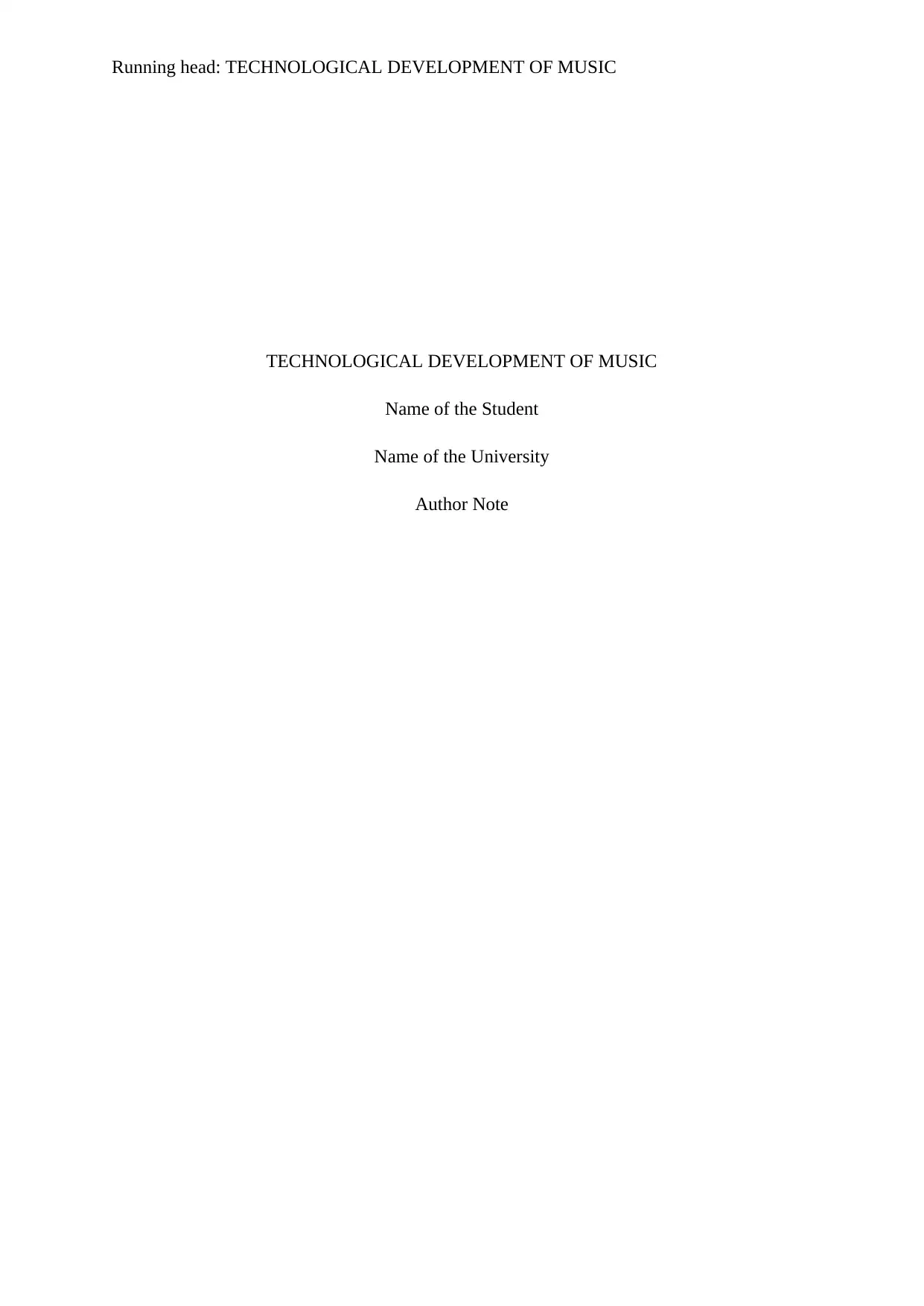
Running head: TECHNOLOGICAL DEVELOPMENT OF MUSIC
TECHNOLOGICAL DEVELOPMENT OF MUSIC
Name of the Student
Name of the University
Author Note
TECHNOLOGICAL DEVELOPMENT OF MUSIC
Name of the Student
Name of the University
Author Note
Secure Best Marks with AI Grader
Need help grading? Try our AI Grader for instant feedback on your assignments.
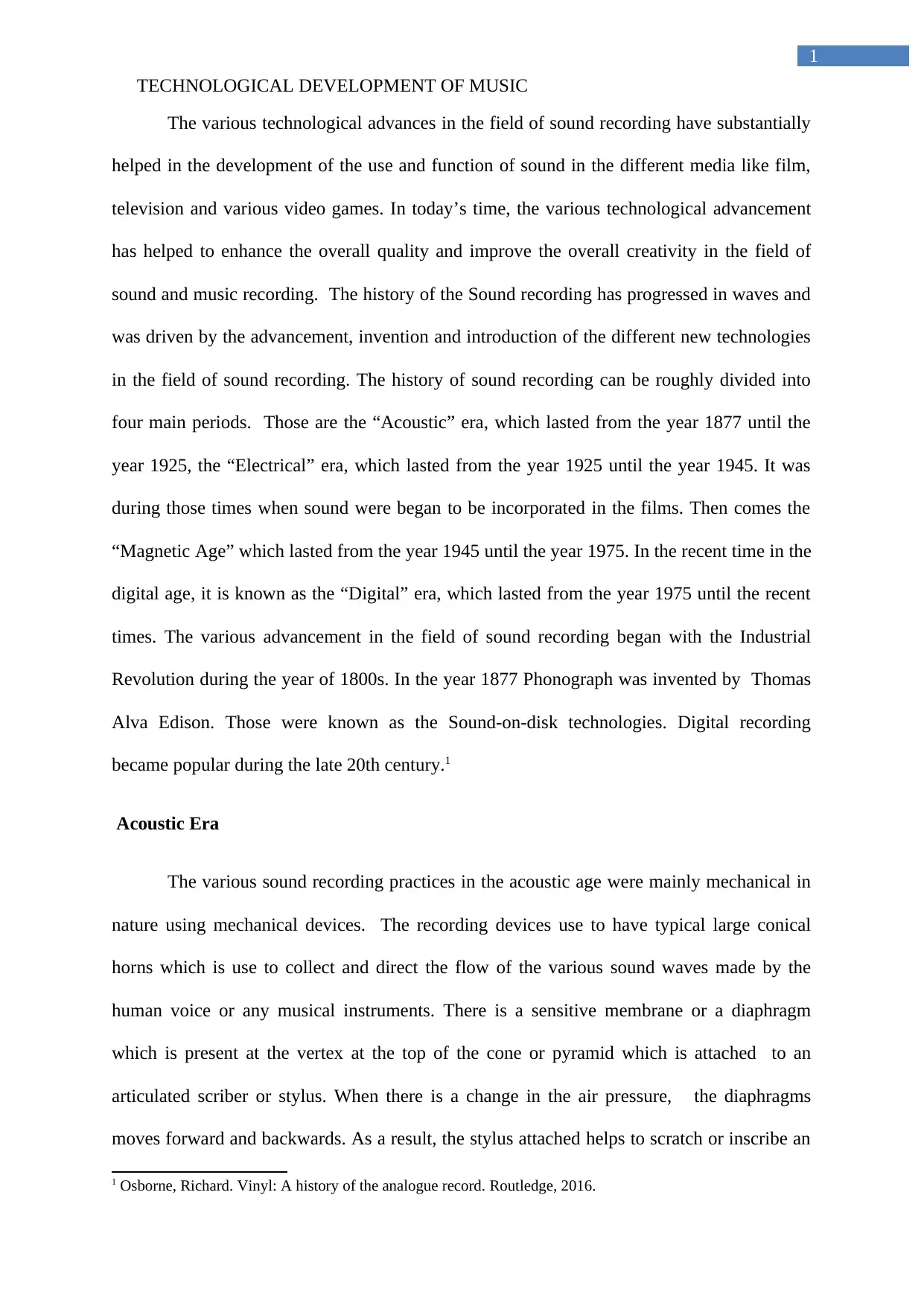
1
TECHNOLOGICAL DEVELOPMENT OF MUSIC
The various technological advances in the field of sound recording have substantially
helped in the development of the use and function of sound in the different media like film,
television and various video games. In today’s time, the various technological advancement
has helped to enhance the overall quality and improve the overall creativity in the field of
sound and music recording. The history of the Sound recording has progressed in waves and
was driven by the advancement, invention and introduction of the different new technologies
in the field of sound recording. The history of sound recording can be roughly divided into
four main periods. Those are the “Acoustic” era, which lasted from the year 1877 until the
year 1925, the “Electrical” era, which lasted from the year 1925 until the year 1945. It was
during those times when sound were began to be incorporated in the films. Then comes the
“Magnetic Age” which lasted from the year 1945 until the year 1975. In the recent time in the
digital age, it is known as the “Digital” era, which lasted from the year 1975 until the recent
times. The various advancement in the field of sound recording began with the Industrial
Revolution during the year of 1800s. In the year 1877 Phonograph was invented by Thomas
Alva Edison. Those were known as the Sound-on-disk technologies. Digital recording
became popular during the late 20th century.1
Acoustic Era
The various sound recording practices in the acoustic age were mainly mechanical in
nature using mechanical devices. The recording devices use to have typical large conical
horns which is use to collect and direct the flow of the various sound waves made by the
human voice or any musical instruments. There is a sensitive membrane or a diaphragm
which is present at the vertex at the top of the cone or pyramid which is attached to an
articulated scriber or stylus. When there is a change in the air pressure, the diaphragms
moves forward and backwards. As a result, the stylus attached helps to scratch or inscribe an
1 Osborne, Richard. Vinyl: A history of the analogue record. Routledge, 2016.
TECHNOLOGICAL DEVELOPMENT OF MUSIC
The various technological advances in the field of sound recording have substantially
helped in the development of the use and function of sound in the different media like film,
television and various video games. In today’s time, the various technological advancement
has helped to enhance the overall quality and improve the overall creativity in the field of
sound and music recording. The history of the Sound recording has progressed in waves and
was driven by the advancement, invention and introduction of the different new technologies
in the field of sound recording. The history of sound recording can be roughly divided into
four main periods. Those are the “Acoustic” era, which lasted from the year 1877 until the
year 1925, the “Electrical” era, which lasted from the year 1925 until the year 1945. It was
during those times when sound were began to be incorporated in the films. Then comes the
“Magnetic Age” which lasted from the year 1945 until the year 1975. In the recent time in the
digital age, it is known as the “Digital” era, which lasted from the year 1975 until the recent
times. The various advancement in the field of sound recording began with the Industrial
Revolution during the year of 1800s. In the year 1877 Phonograph was invented by Thomas
Alva Edison. Those were known as the Sound-on-disk technologies. Digital recording
became popular during the late 20th century.1
Acoustic Era
The various sound recording practices in the acoustic age were mainly mechanical in
nature using mechanical devices. The recording devices use to have typical large conical
horns which is use to collect and direct the flow of the various sound waves made by the
human voice or any musical instruments. There is a sensitive membrane or a diaphragm
which is present at the vertex at the top of the cone or pyramid which is attached to an
articulated scriber or stylus. When there is a change in the air pressure, the diaphragms
moves forward and backwards. As a result, the stylus attached helps to scratch or inscribe an
1 Osborne, Richard. Vinyl: A history of the analogue record. Routledge, 2016.
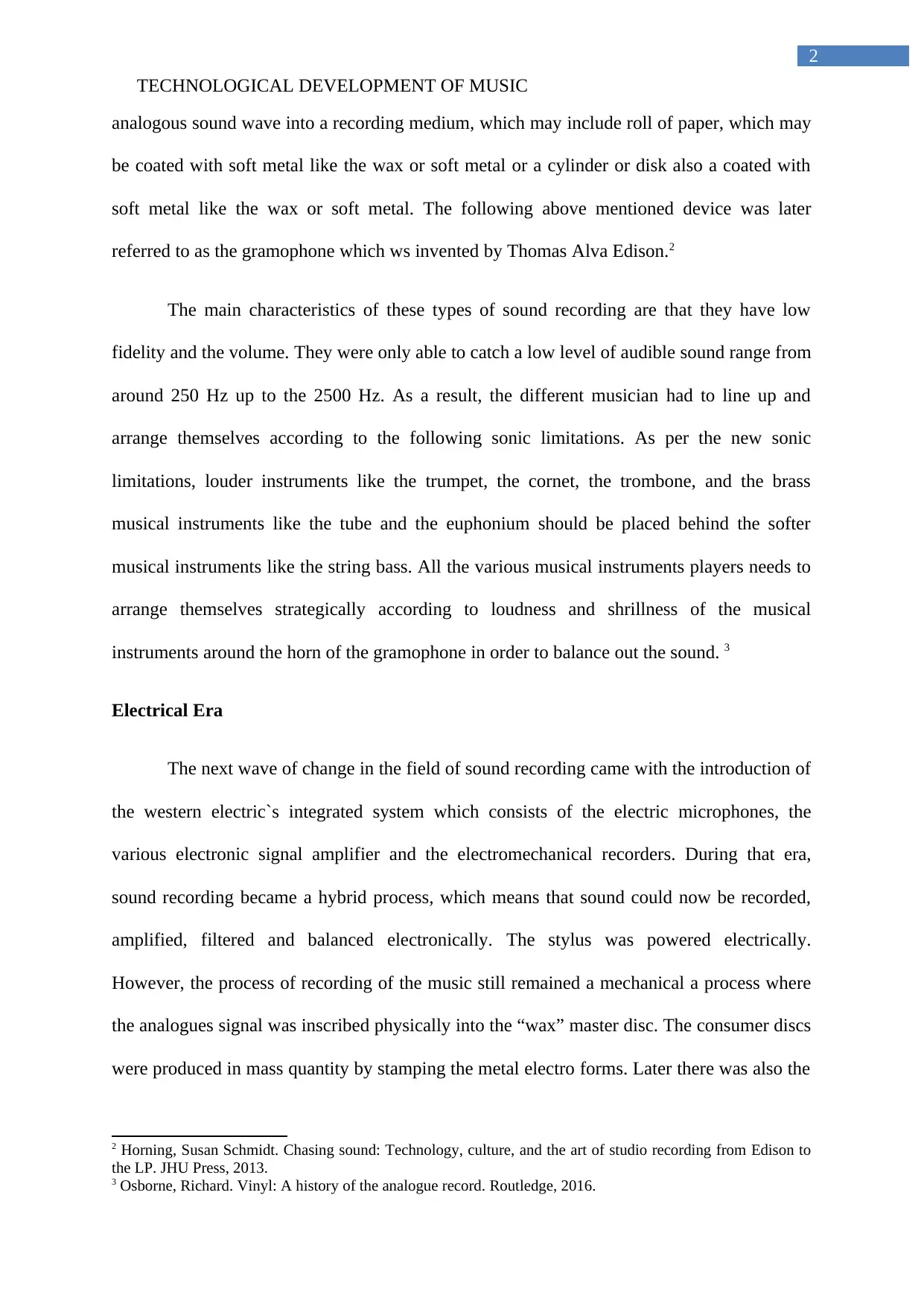
2
TECHNOLOGICAL DEVELOPMENT OF MUSIC
analogous sound wave into a recording medium, which may include roll of paper, which may
be coated with soft metal like the wax or soft metal or a cylinder or disk also a coated with
soft metal like the wax or soft metal. The following above mentioned device was later
referred to as the gramophone which ws invented by Thomas Alva Edison.2
The main characteristics of these types of sound recording are that they have low
fidelity and the volume. They were only able to catch a low level of audible sound range from
around 250 Hz up to the 2500 Hz. As a result, the different musician had to line up and
arrange themselves according to the following sonic limitations. As per the new sonic
limitations, louder instruments like the trumpet, the cornet, the trombone, and the brass
musical instruments like the tube and the euphonium should be placed behind the softer
musical instruments like the string bass. All the various musical instruments players needs to
arrange themselves strategically according to loudness and shrillness of the musical
instruments around the horn of the gramophone in order to balance out the sound. 3
Electrical Era
The next wave of change in the field of sound recording came with the introduction of
the western electric`s integrated system which consists of the electric microphones, the
various electronic signal amplifier and the electromechanical recorders. During that era,
sound recording became a hybrid process, which means that sound could now be recorded,
amplified, filtered and balanced electronically. The stylus was powered electrically.
However, the process of recording of the music still remained a mechanical a process where
the analogues signal was inscribed physically into the “wax” master disc. The consumer discs
were produced in mass quantity by stamping the metal electro forms. Later there was also the
2 Horning, Susan Schmidt. Chasing sound: Technology, culture, and the art of studio recording from Edison to
the LP. JHU Press, 2013.
3 Osborne, Richard. Vinyl: A history of the analogue record. Routledge, 2016.
TECHNOLOGICAL DEVELOPMENT OF MUSIC
analogous sound wave into a recording medium, which may include roll of paper, which may
be coated with soft metal like the wax or soft metal or a cylinder or disk also a coated with
soft metal like the wax or soft metal. The following above mentioned device was later
referred to as the gramophone which ws invented by Thomas Alva Edison.2
The main characteristics of these types of sound recording are that they have low
fidelity and the volume. They were only able to catch a low level of audible sound range from
around 250 Hz up to the 2500 Hz. As a result, the different musician had to line up and
arrange themselves according to the following sonic limitations. As per the new sonic
limitations, louder instruments like the trumpet, the cornet, the trombone, and the brass
musical instruments like the tube and the euphonium should be placed behind the softer
musical instruments like the string bass. All the various musical instruments players needs to
arrange themselves strategically according to loudness and shrillness of the musical
instruments around the horn of the gramophone in order to balance out the sound. 3
Electrical Era
The next wave of change in the field of sound recording came with the introduction of
the western electric`s integrated system which consists of the electric microphones, the
various electronic signal amplifier and the electromechanical recorders. During that era,
sound recording became a hybrid process, which means that sound could now be recorded,
amplified, filtered and balanced electronically. The stylus was powered electrically.
However, the process of recording of the music still remained a mechanical a process where
the analogues signal was inscribed physically into the “wax” master disc. The consumer discs
were produced in mass quantity by stamping the metal electro forms. Later there was also the
2 Horning, Susan Schmidt. Chasing sound: Technology, culture, and the art of studio recording from Edison to
the LP. JHU Press, 2013.
3 Osborne, Richard. Vinyl: A history of the analogue record. Routledge, 2016.
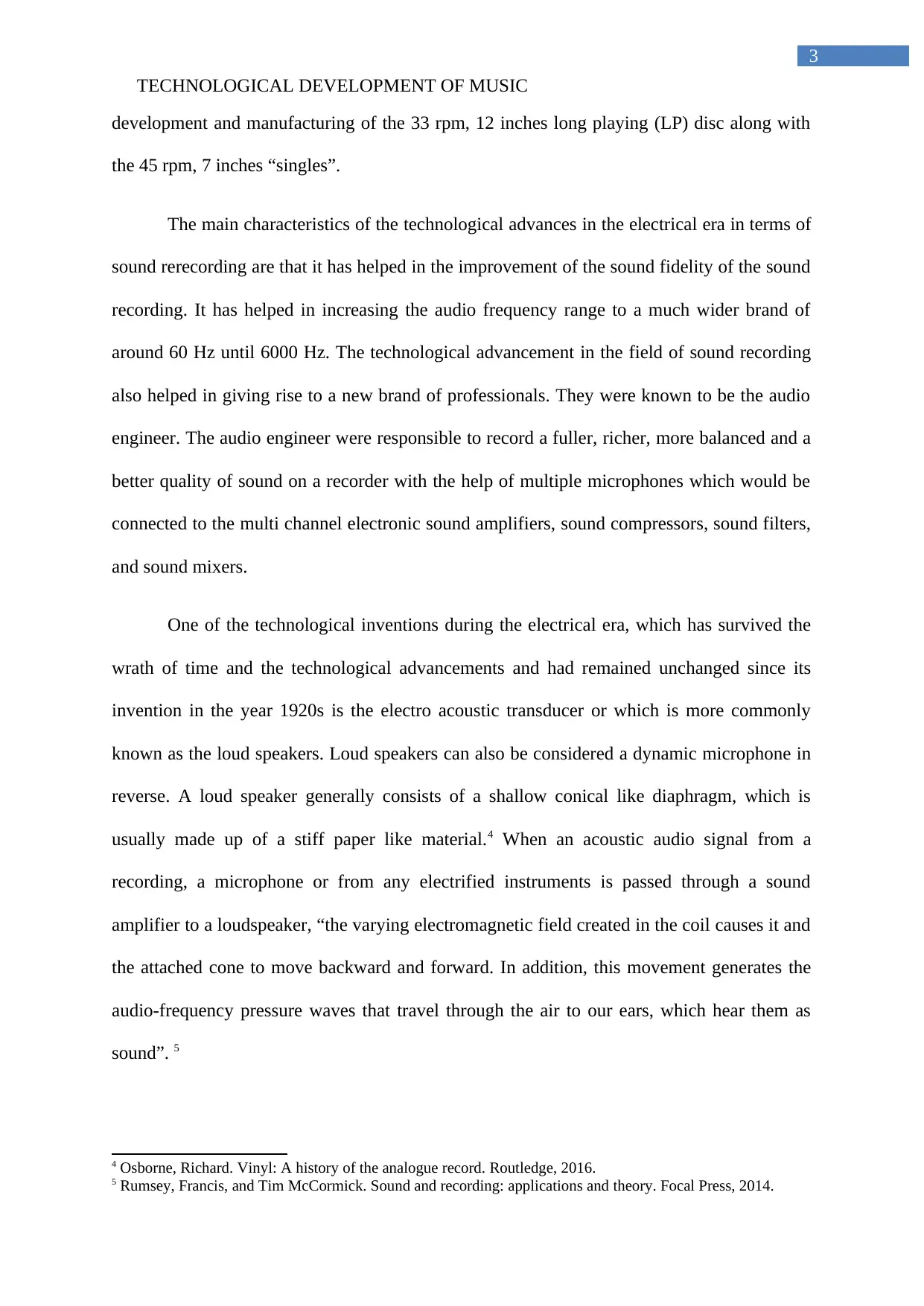
3
TECHNOLOGICAL DEVELOPMENT OF MUSIC
development and manufacturing of the 33 rpm, 12 inches long playing (LP) disc along with
the 45 rpm, 7 inches “singles”.
The main characteristics of the technological advances in the electrical era in terms of
sound rerecording are that it has helped in the improvement of the sound fidelity of the sound
recording. It has helped in increasing the audio frequency range to a much wider brand of
around 60 Hz until 6000 Hz. The technological advancement in the field of sound recording
also helped in giving rise to a new brand of professionals. They were known to be the audio
engineer. The audio engineer were responsible to record a fuller, richer, more balanced and a
better quality of sound on a recorder with the help of multiple microphones which would be
connected to the multi channel electronic sound amplifiers, sound compressors, sound filters,
and sound mixers.
One of the technological inventions during the electrical era, which has survived the
wrath of time and the technological advancements and had remained unchanged since its
invention in the year 1920s is the electro acoustic transducer or which is more commonly
known as the loud speakers. Loud speakers can also be considered a dynamic microphone in
reverse. A loud speaker generally consists of a shallow conical like diaphragm, which is
usually made up of a stiff paper like material.4 When an acoustic audio signal from a
recording, a microphone or from any electrified instruments is passed through a sound
amplifier to a loudspeaker, “the varying electromagnetic field created in the coil causes it and
the attached cone to move backward and forward. In addition, this movement generates the
audio-frequency pressure waves that travel through the air to our ears, which hear them as
sound”. 5
4 Osborne, Richard. Vinyl: A history of the analogue record. Routledge, 2016.
5 Rumsey, Francis, and Tim McCormick. Sound and recording: applications and theory. Focal Press, 2014.
TECHNOLOGICAL DEVELOPMENT OF MUSIC
development and manufacturing of the 33 rpm, 12 inches long playing (LP) disc along with
the 45 rpm, 7 inches “singles”.
The main characteristics of the technological advances in the electrical era in terms of
sound rerecording are that it has helped in the improvement of the sound fidelity of the sound
recording. It has helped in increasing the audio frequency range to a much wider brand of
around 60 Hz until 6000 Hz. The technological advancement in the field of sound recording
also helped in giving rise to a new brand of professionals. They were known to be the audio
engineer. The audio engineer were responsible to record a fuller, richer, more balanced and a
better quality of sound on a recorder with the help of multiple microphones which would be
connected to the multi channel electronic sound amplifiers, sound compressors, sound filters,
and sound mixers.
One of the technological inventions during the electrical era, which has survived the
wrath of time and the technological advancements and had remained unchanged since its
invention in the year 1920s is the electro acoustic transducer or which is more commonly
known as the loud speakers. Loud speakers can also be considered a dynamic microphone in
reverse. A loud speaker generally consists of a shallow conical like diaphragm, which is
usually made up of a stiff paper like material.4 When an acoustic audio signal from a
recording, a microphone or from any electrified instruments is passed through a sound
amplifier to a loudspeaker, “the varying electromagnetic field created in the coil causes it and
the attached cone to move backward and forward. In addition, this movement generates the
audio-frequency pressure waves that travel through the air to our ears, which hear them as
sound”. 5
4 Osborne, Richard. Vinyl: A history of the analogue record. Routledge, 2016.
5 Rumsey, Francis, and Tim McCormick. Sound and recording: applications and theory. Focal Press, 2014.
Secure Best Marks with AI Grader
Need help grading? Try our AI Grader for instant feedback on your assignments.
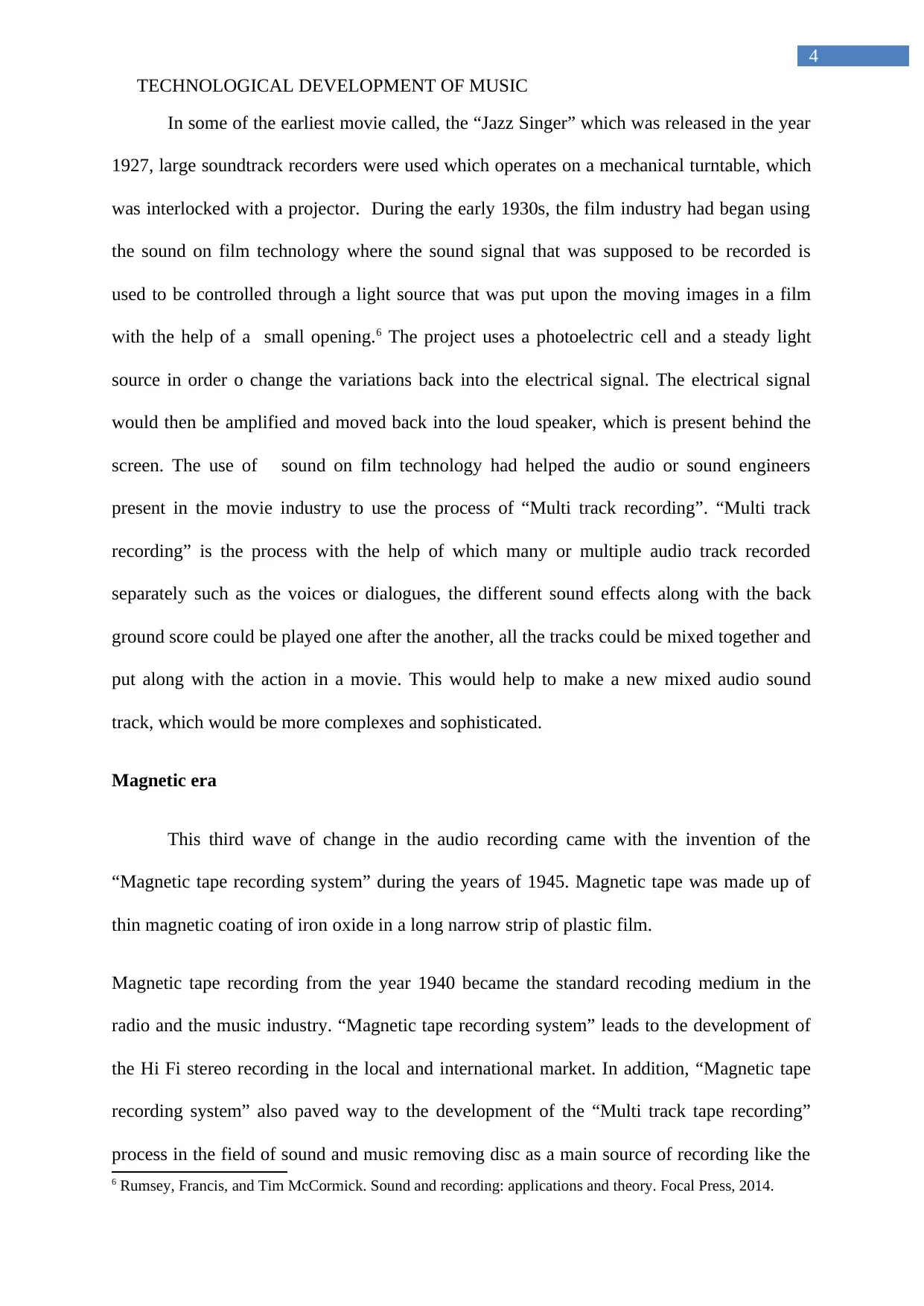
4
TECHNOLOGICAL DEVELOPMENT OF MUSIC
In some of the earliest movie called, the “Jazz Singer” which was released in the year
1927, large soundtrack recorders were used which operates on a mechanical turntable, which
was interlocked with a projector. During the early 1930s, the film industry had began using
the sound on film technology where the sound signal that was supposed to be recorded is
used to be controlled through a light source that was put upon the moving images in a film
with the help of a small opening.6 The project uses a photoelectric cell and a steady light
source in order o change the variations back into the electrical signal. The electrical signal
would then be amplified and moved back into the loud speaker, which is present behind the
screen. The use of sound on film technology had helped the audio or sound engineers
present in the movie industry to use the process of “Multi track recording”. “Multi track
recording” is the process with the help of which many or multiple audio track recorded
separately such as the voices or dialogues, the different sound effects along with the back
ground score could be played one after the another, all the tracks could be mixed together and
put along with the action in a movie. This would help to make a new mixed audio sound
track, which would be more complexes and sophisticated.
Magnetic era
This third wave of change in the audio recording came with the invention of the
“Magnetic tape recording system” during the years of 1945. Magnetic tape was made up of
thin magnetic coating of iron oxide in a long narrow strip of plastic film.
Magnetic tape recording from the year 1940 became the standard recoding medium in the
radio and the music industry. “Magnetic tape recording system” leads to the development of
the Hi Fi stereo recording in the local and international market. In addition, “Magnetic tape
recording system” also paved way to the development of the “Multi track tape recording”
process in the field of sound and music removing disc as a main source of recording like the
6 Rumsey, Francis, and Tim McCormick. Sound and recording: applications and theory. Focal Press, 2014.
TECHNOLOGICAL DEVELOPMENT OF MUSIC
In some of the earliest movie called, the “Jazz Singer” which was released in the year
1927, large soundtrack recorders were used which operates on a mechanical turntable, which
was interlocked with a projector. During the early 1930s, the film industry had began using
the sound on film technology where the sound signal that was supposed to be recorded is
used to be controlled through a light source that was put upon the moving images in a film
with the help of a small opening.6 The project uses a photoelectric cell and a steady light
source in order o change the variations back into the electrical signal. The electrical signal
would then be amplified and moved back into the loud speaker, which is present behind the
screen. The use of sound on film technology had helped the audio or sound engineers
present in the movie industry to use the process of “Multi track recording”. “Multi track
recording” is the process with the help of which many or multiple audio track recorded
separately such as the voices or dialogues, the different sound effects along with the back
ground score could be played one after the another, all the tracks could be mixed together and
put along with the action in a movie. This would help to make a new mixed audio sound
track, which would be more complexes and sophisticated.
Magnetic era
This third wave of change in the audio recording came with the invention of the
“Magnetic tape recording system” during the years of 1945. Magnetic tape was made up of
thin magnetic coating of iron oxide in a long narrow strip of plastic film.
Magnetic tape recording from the year 1940 became the standard recoding medium in the
radio and the music industry. “Magnetic tape recording system” leads to the development of
the Hi Fi stereo recording in the local and international market. In addition, “Magnetic tape
recording system” also paved way to the development of the “Multi track tape recording”
process in the field of sound and music removing disc as a main source of recording like the
6 Rumsey, Francis, and Tim McCormick. Sound and recording: applications and theory. Focal Press, 2014.
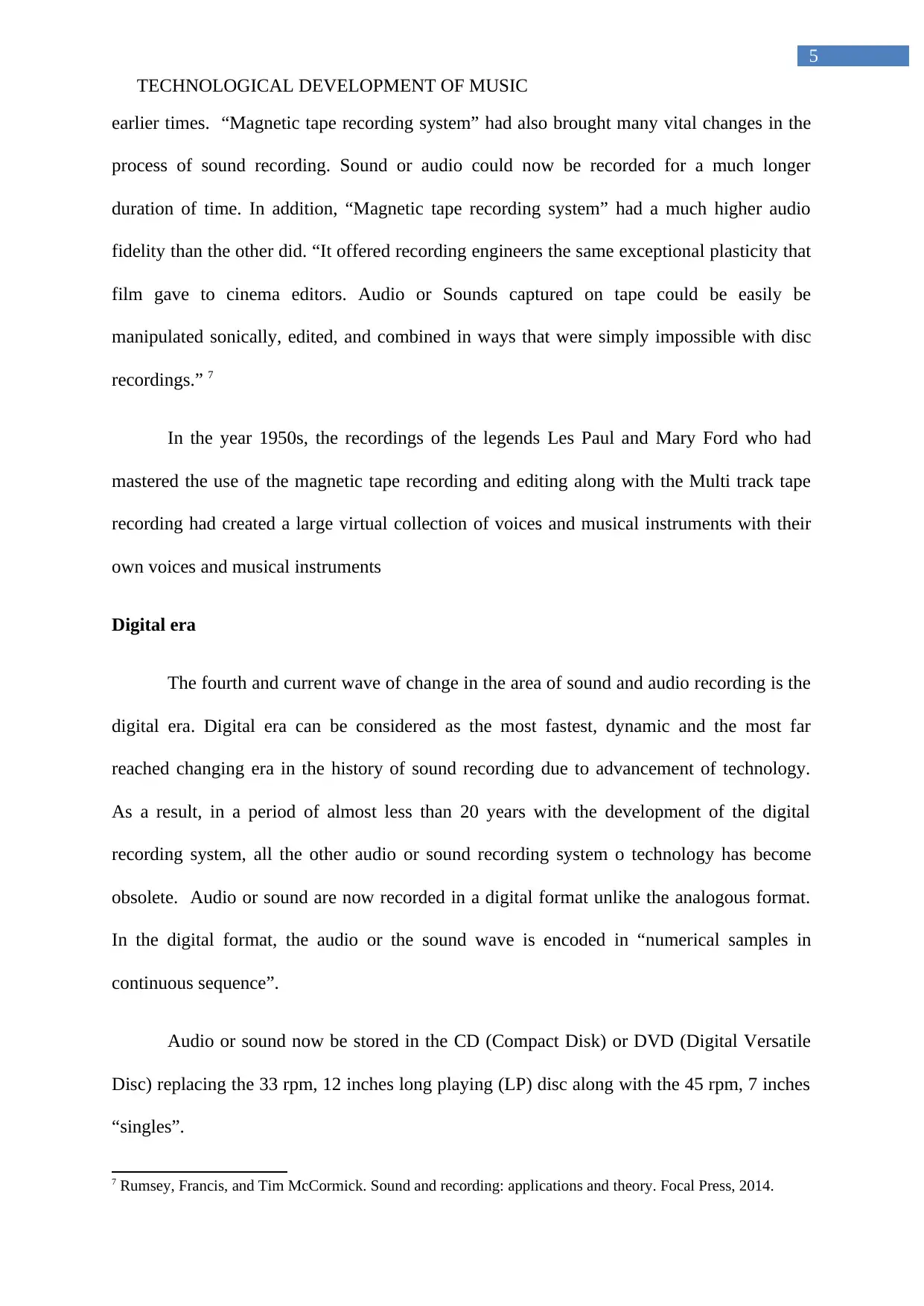
5
TECHNOLOGICAL DEVELOPMENT OF MUSIC
earlier times. “Magnetic tape recording system” had also brought many vital changes in the
process of sound recording. Sound or audio could now be recorded for a much longer
duration of time. In addition, “Magnetic tape recording system” had a much higher audio
fidelity than the other did. “It offered recording engineers the same exceptional plasticity that
film gave to cinema editors. Audio or Sounds captured on tape could be easily be
manipulated sonically, edited, and combined in ways that were simply impossible with disc
recordings.” 7
In the year 1950s, the recordings of the legends Les Paul and Mary Ford who had
mastered the use of the magnetic tape recording and editing along with the Multi track tape
recording had created a large virtual collection of voices and musical instruments with their
own voices and musical instruments
Digital era
The fourth and current wave of change in the area of sound and audio recording is the
digital era. Digital era can be considered as the most fastest, dynamic and the most far
reached changing era in the history of sound recording due to advancement of technology.
As a result, in a period of almost less than 20 years with the development of the digital
recording system, all the other audio or sound recording system o technology has become
obsolete. Audio or sound are now recorded in a digital format unlike the analogous format.
In the digital format, the audio or the sound wave is encoded in “numerical samples in
continuous sequence”.
Audio or sound now be stored in the CD (Compact Disk) or DVD (Digital Versatile
Disc) replacing the 33 rpm, 12 inches long playing (LP) disc along with the 45 rpm, 7 inches
“singles”.
7 Rumsey, Francis, and Tim McCormick. Sound and recording: applications and theory. Focal Press, 2014.
TECHNOLOGICAL DEVELOPMENT OF MUSIC
earlier times. “Magnetic tape recording system” had also brought many vital changes in the
process of sound recording. Sound or audio could now be recorded for a much longer
duration of time. In addition, “Magnetic tape recording system” had a much higher audio
fidelity than the other did. “It offered recording engineers the same exceptional plasticity that
film gave to cinema editors. Audio or Sounds captured on tape could be easily be
manipulated sonically, edited, and combined in ways that were simply impossible with disc
recordings.” 7
In the year 1950s, the recordings of the legends Les Paul and Mary Ford who had
mastered the use of the magnetic tape recording and editing along with the Multi track tape
recording had created a large virtual collection of voices and musical instruments with their
own voices and musical instruments
Digital era
The fourth and current wave of change in the area of sound and audio recording is the
digital era. Digital era can be considered as the most fastest, dynamic and the most far
reached changing era in the history of sound recording due to advancement of technology.
As a result, in a period of almost less than 20 years with the development of the digital
recording system, all the other audio or sound recording system o technology has become
obsolete. Audio or sound are now recorded in a digital format unlike the analogous format.
In the digital format, the audio or the sound wave is encoded in “numerical samples in
continuous sequence”.
Audio or sound now be stored in the CD (Compact Disk) or DVD (Digital Versatile
Disc) replacing the 33 rpm, 12 inches long playing (LP) disc along with the 45 rpm, 7 inches
“singles”.
7 Rumsey, Francis, and Tim McCormick. Sound and recording: applications and theory. Focal Press, 2014.
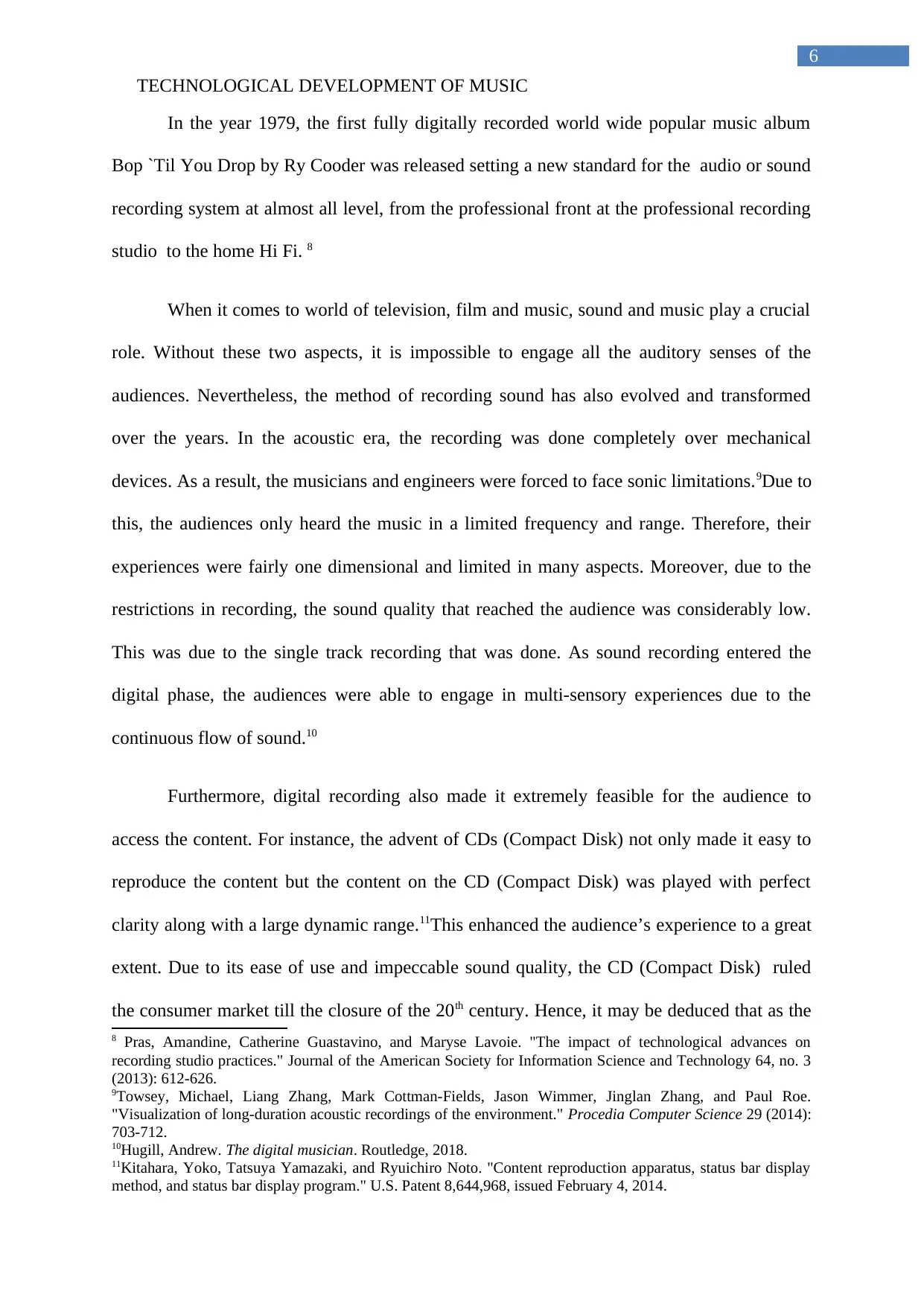
6
TECHNOLOGICAL DEVELOPMENT OF MUSIC
In the year 1979, the first fully digitally recorded world wide popular music album
Bop `Til You Drop by Ry Cooder was released setting a new standard for the audio or sound
recording system at almost all level, from the professional front at the professional recording
studio to the home Hi Fi. 8
When it comes to world of television, film and music, sound and music play a crucial
role. Without these two aspects, it is impossible to engage all the auditory senses of the
audiences. Nevertheless, the method of recording sound has also evolved and transformed
over the years. In the acoustic era, the recording was done completely over mechanical
devices. As a result, the musicians and engineers were forced to face sonic limitations.9Due to
this, the audiences only heard the music in a limited frequency and range. Therefore, their
experiences were fairly one dimensional and limited in many aspects. Moreover, due to the
restrictions in recording, the sound quality that reached the audience was considerably low.
This was due to the single track recording that was done. As sound recording entered the
digital phase, the audiences were able to engage in multi-sensory experiences due to the
continuous flow of sound.10
Furthermore, digital recording also made it extremely feasible for the audience to
access the content. For instance, the advent of CDs (Compact Disk) not only made it easy to
reproduce the content but the content on the CD (Compact Disk) was played with perfect
clarity along with a large dynamic range.11This enhanced the audience’s experience to a great
extent. Due to its ease of use and impeccable sound quality, the CD (Compact Disk) ruled
the consumer market till the closure of the 20th century. Hence, it may be deduced that as the
8 Pras, Amandine, Catherine Guastavino, and Maryse Lavoie. "The impact of technological advances on
recording studio practices." Journal of the American Society for Information Science and Technology 64, no. 3
(2013): 612-626.
9Towsey, Michael, Liang Zhang, Mark Cottman-Fields, Jason Wimmer, Jinglan Zhang, and Paul Roe.
"Visualization of long-duration acoustic recordings of the environment." Procedia Computer Science 29 (2014):
703-712.
10Hugill, Andrew. The digital musician. Routledge, 2018.
11Kitahara, Yoko, Tatsuya Yamazaki, and Ryuichiro Noto. "Content reproduction apparatus, status bar display
method, and status bar display program." U.S. Patent 8,644,968, issued February 4, 2014.
TECHNOLOGICAL DEVELOPMENT OF MUSIC
In the year 1979, the first fully digitally recorded world wide popular music album
Bop `Til You Drop by Ry Cooder was released setting a new standard for the audio or sound
recording system at almost all level, from the professional front at the professional recording
studio to the home Hi Fi. 8
When it comes to world of television, film and music, sound and music play a crucial
role. Without these two aspects, it is impossible to engage all the auditory senses of the
audiences. Nevertheless, the method of recording sound has also evolved and transformed
over the years. In the acoustic era, the recording was done completely over mechanical
devices. As a result, the musicians and engineers were forced to face sonic limitations.9Due to
this, the audiences only heard the music in a limited frequency and range. Therefore, their
experiences were fairly one dimensional and limited in many aspects. Moreover, due to the
restrictions in recording, the sound quality that reached the audience was considerably low.
This was due to the single track recording that was done. As sound recording entered the
digital phase, the audiences were able to engage in multi-sensory experiences due to the
continuous flow of sound.10
Furthermore, digital recording also made it extremely feasible for the audience to
access the content. For instance, the advent of CDs (Compact Disk) not only made it easy to
reproduce the content but the content on the CD (Compact Disk) was played with perfect
clarity along with a large dynamic range.11This enhanced the audience’s experience to a great
extent. Due to its ease of use and impeccable sound quality, the CD (Compact Disk) ruled
the consumer market till the closure of the 20th century. Hence, it may be deduced that as the
8 Pras, Amandine, Catherine Guastavino, and Maryse Lavoie. "The impact of technological advances on
recording studio practices." Journal of the American Society for Information Science and Technology 64, no. 3
(2013): 612-626.
9Towsey, Michael, Liang Zhang, Mark Cottman-Fields, Jason Wimmer, Jinglan Zhang, and Paul Roe.
"Visualization of long-duration acoustic recordings of the environment." Procedia Computer Science 29 (2014):
703-712.
10Hugill, Andrew. The digital musician. Routledge, 2018.
11Kitahara, Yoko, Tatsuya Yamazaki, and Ryuichiro Noto. "Content reproduction apparatus, status bar display
method, and status bar display program." U.S. Patent 8,644,968, issued February 4, 2014.
Paraphrase This Document
Need a fresh take? Get an instant paraphrase of this document with our AI Paraphraser
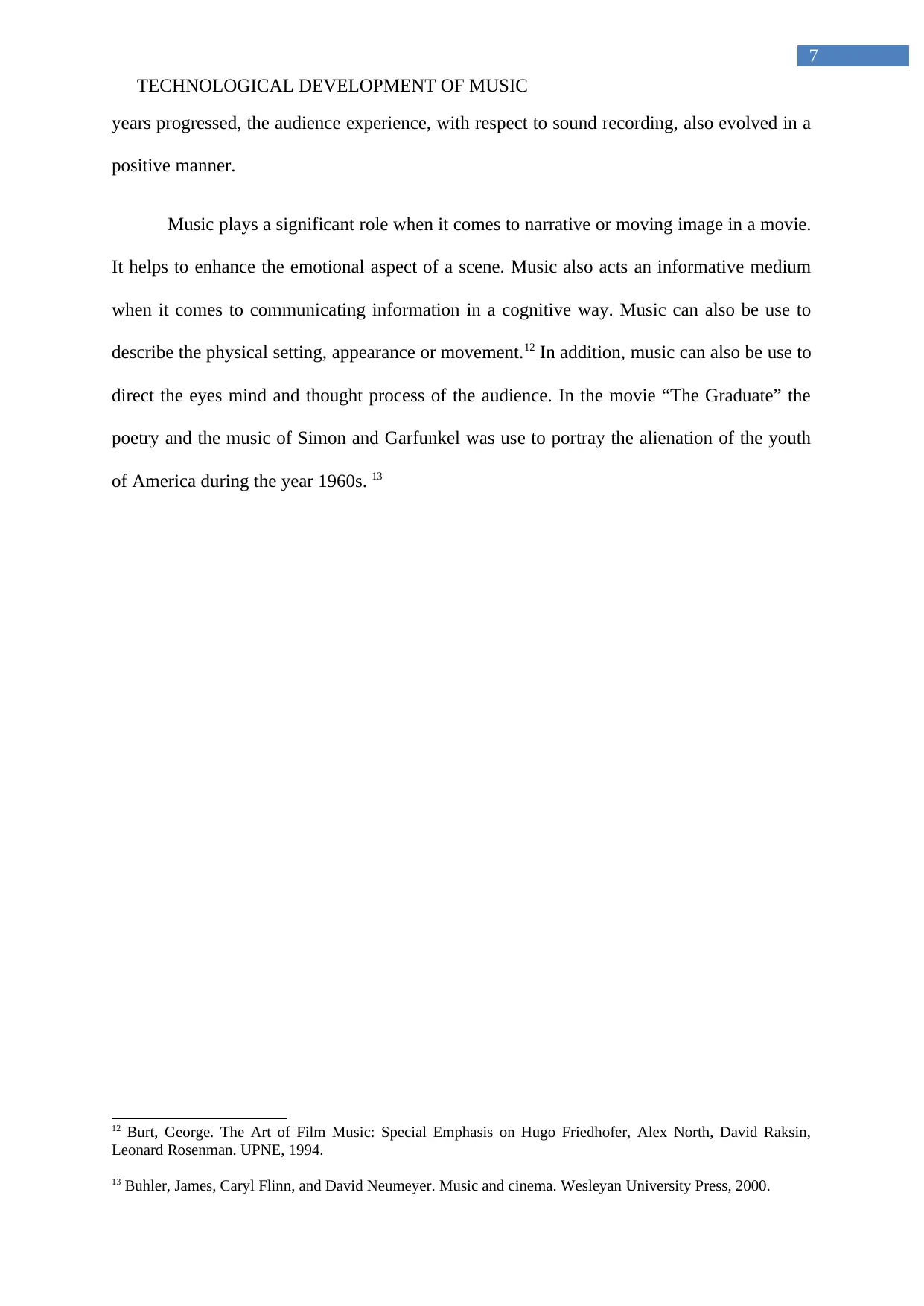
7
TECHNOLOGICAL DEVELOPMENT OF MUSIC
years progressed, the audience experience, with respect to sound recording, also evolved in a
positive manner.
Music plays a significant role when it comes to narrative or moving image in a movie.
It helps to enhance the emotional aspect of a scene. Music also acts an informative medium
when it comes to communicating information in a cognitive way. Music can also be use to
describe the physical setting, appearance or movement.12 In addition, music can also be use to
direct the eyes mind and thought process of the audience. In the movie “The Graduate” the
poetry and the music of Simon and Garfunkel was use to portray the alienation of the youth
of America during the year 1960s. 13
12 Burt, George. The Art of Film Music: Special Emphasis on Hugo Friedhofer, Alex North, David Raksin,
Leonard Rosenman. UPNE, 1994.
13 Buhler, James, Caryl Flinn, and David Neumeyer. Music and cinema. Wesleyan University Press, 2000.
TECHNOLOGICAL DEVELOPMENT OF MUSIC
years progressed, the audience experience, with respect to sound recording, also evolved in a
positive manner.
Music plays a significant role when it comes to narrative or moving image in a movie.
It helps to enhance the emotional aspect of a scene. Music also acts an informative medium
when it comes to communicating information in a cognitive way. Music can also be use to
describe the physical setting, appearance or movement.12 In addition, music can also be use to
direct the eyes mind and thought process of the audience. In the movie “The Graduate” the
poetry and the music of Simon and Garfunkel was use to portray the alienation of the youth
of America during the year 1960s. 13
12 Burt, George. The Art of Film Music: Special Emphasis on Hugo Friedhofer, Alex North, David Raksin,
Leonard Rosenman. UPNE, 1994.
13 Buhler, James, Caryl Flinn, and David Neumeyer. Music and cinema. Wesleyan University Press, 2000.
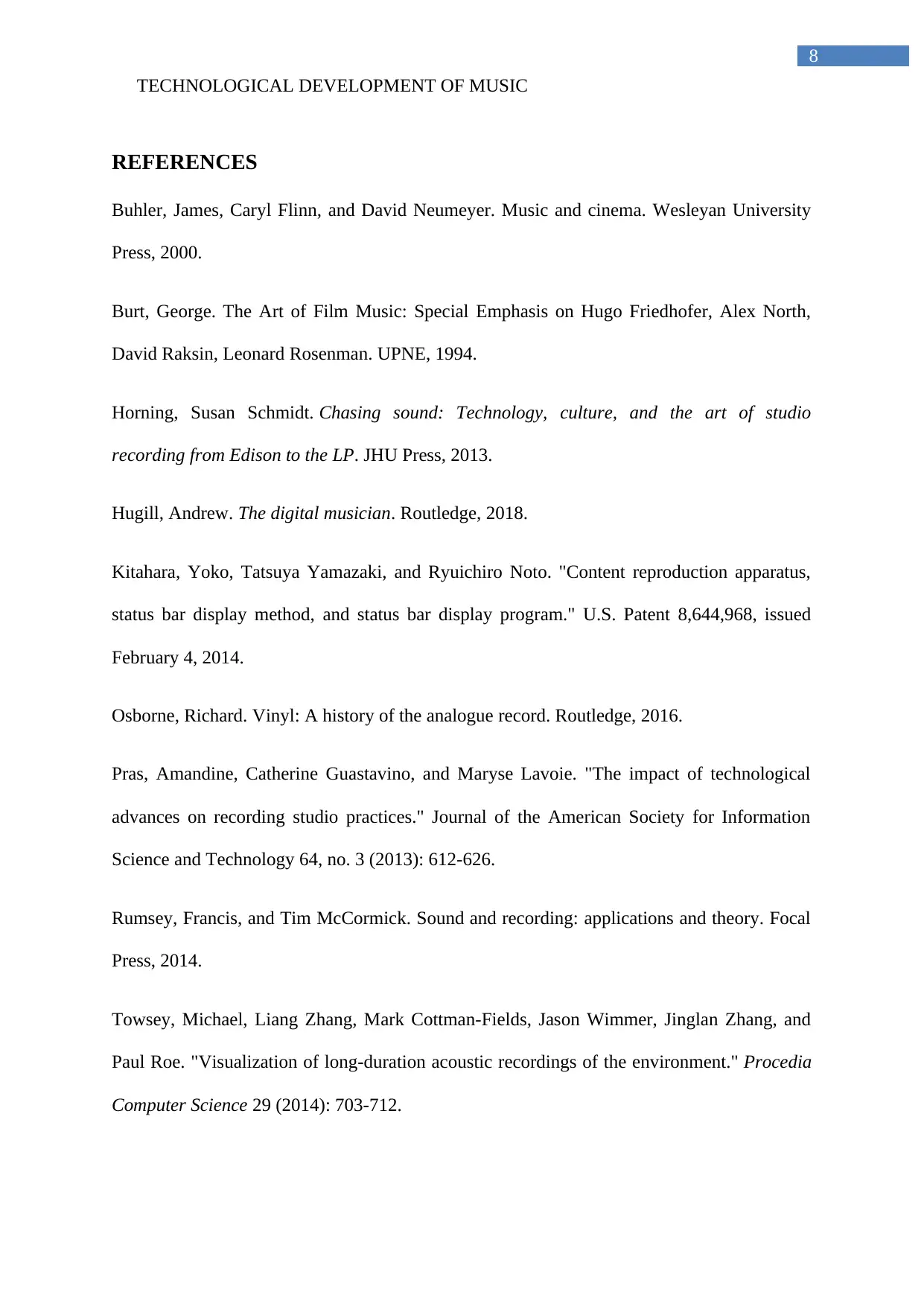
8
TECHNOLOGICAL DEVELOPMENT OF MUSIC
REFERENCES
Buhler, James, Caryl Flinn, and David Neumeyer. Music and cinema. Wesleyan University
Press, 2000.
Burt, George. The Art of Film Music: Special Emphasis on Hugo Friedhofer, Alex North,
David Raksin, Leonard Rosenman. UPNE, 1994.
Horning, Susan Schmidt. Chasing sound: Technology, culture, and the art of studio
recording from Edison to the LP. JHU Press, 2013.
Hugill, Andrew. The digital musician. Routledge, 2018.
Kitahara, Yoko, Tatsuya Yamazaki, and Ryuichiro Noto. "Content reproduction apparatus,
status bar display method, and status bar display program." U.S. Patent 8,644,968, issued
February 4, 2014.
Osborne, Richard. Vinyl: A history of the analogue record. Routledge, 2016.
Pras, Amandine, Catherine Guastavino, and Maryse Lavoie. "The impact of technological
advances on recording studio practices." Journal of the American Society for Information
Science and Technology 64, no. 3 (2013): 612-626.
Rumsey, Francis, and Tim McCormick. Sound and recording: applications and theory. Focal
Press, 2014.
Towsey, Michael, Liang Zhang, Mark Cottman-Fields, Jason Wimmer, Jinglan Zhang, and
Paul Roe. "Visualization of long-duration acoustic recordings of the environment." Procedia
Computer Science 29 (2014): 703-712.
TECHNOLOGICAL DEVELOPMENT OF MUSIC
REFERENCES
Buhler, James, Caryl Flinn, and David Neumeyer. Music and cinema. Wesleyan University
Press, 2000.
Burt, George. The Art of Film Music: Special Emphasis on Hugo Friedhofer, Alex North,
David Raksin, Leonard Rosenman. UPNE, 1994.
Horning, Susan Schmidt. Chasing sound: Technology, culture, and the art of studio
recording from Edison to the LP. JHU Press, 2013.
Hugill, Andrew. The digital musician. Routledge, 2018.
Kitahara, Yoko, Tatsuya Yamazaki, and Ryuichiro Noto. "Content reproduction apparatus,
status bar display method, and status bar display program." U.S. Patent 8,644,968, issued
February 4, 2014.
Osborne, Richard. Vinyl: A history of the analogue record. Routledge, 2016.
Pras, Amandine, Catherine Guastavino, and Maryse Lavoie. "The impact of technological
advances on recording studio practices." Journal of the American Society for Information
Science and Technology 64, no. 3 (2013): 612-626.
Rumsey, Francis, and Tim McCormick. Sound and recording: applications and theory. Focal
Press, 2014.
Towsey, Michael, Liang Zhang, Mark Cottman-Fields, Jason Wimmer, Jinglan Zhang, and
Paul Roe. "Visualization of long-duration acoustic recordings of the environment." Procedia
Computer Science 29 (2014): 703-712.
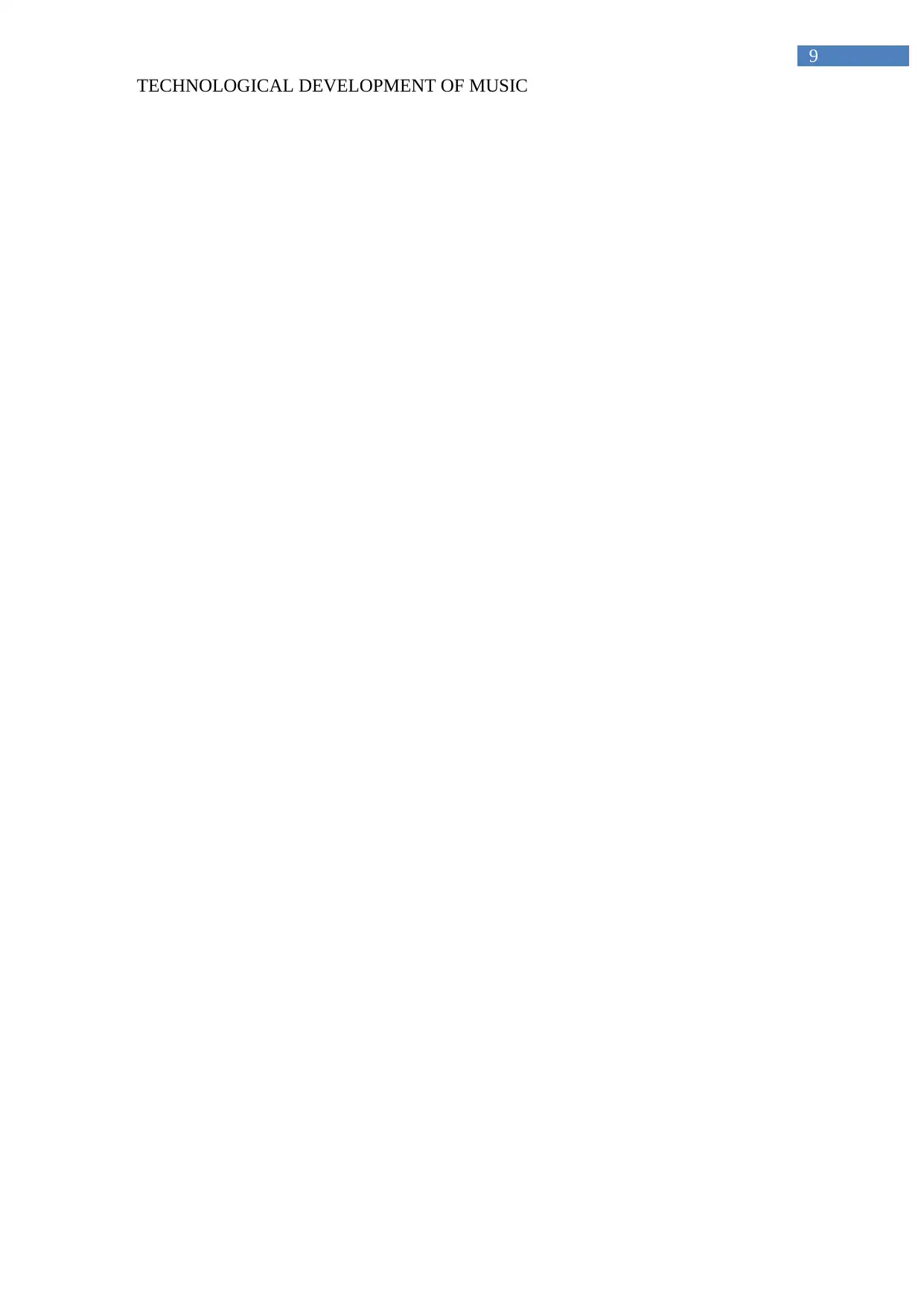
9
TECHNOLOGICAL DEVELOPMENT OF MUSIC
TECHNOLOGICAL DEVELOPMENT OF MUSIC
1 out of 10
Your All-in-One AI-Powered Toolkit for Academic Success.
+13062052269
info@desklib.com
Available 24*7 on WhatsApp / Email
![[object Object]](/_next/static/media/star-bottom.7253800d.svg)
Unlock your academic potential
© 2024 | Zucol Services PVT LTD | All rights reserved.